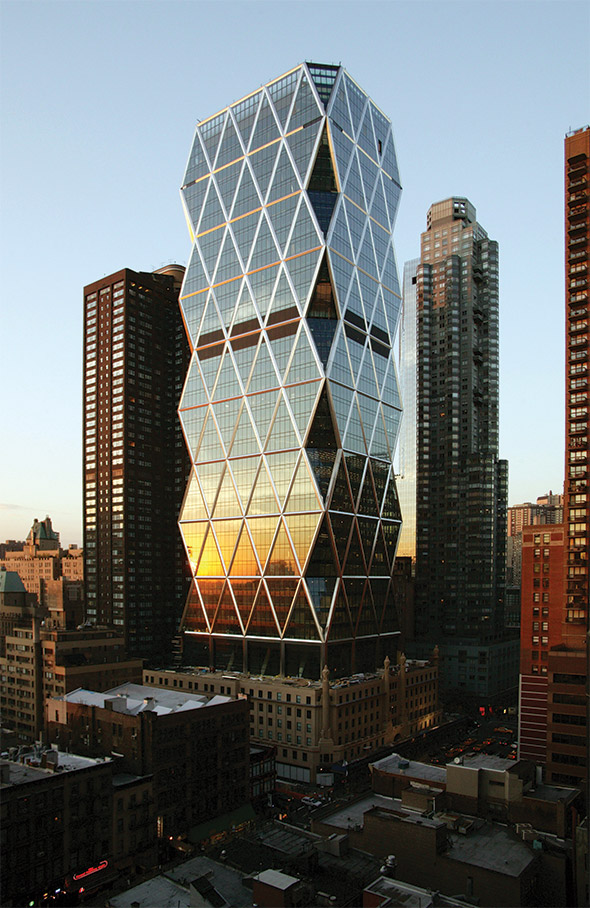
Text by Steven Snyder
Photography by Michael Ficeto
Zigging and zagging up the Manhattan skyline, an organic gem blooms in a sea of simple, sterile facades that almost seem archaic in comparison. It is the Hearst Tower, the looming and arresting new headquarters of the Hearst media empire located in midtown Manhattan which opened its lobby a few months ago and is only now moving in the last of its tenants to their new offices. Designed by Lord Foster, the Tower has emerged as one of the most striking departures of the evolving New York City skyline. Its unexpected fusion of a modern skyscraper with an original 1928 base exemplifies the way in which every aspect of its construction has been conceived with the environment in mind. Ushering in a new era of high-rise philosophies, the Hearst Tower is set to become the first truly green skyscraper in the nation’s largest city.
The United States Green Building Council – which has become an increasingly important advocate of environment-friendly building designs – issues ratings to projects based on their use of green-friendly techniques, with “gold” being the highest designation. The Hearst Tower is expected to be the first project in New York City to receive a gold rating for “core and shell and interiors,” reflecting its thorough use of innovative technologies.
The innovation starts with its frame – the jagged exterior that stands in stark contrast with the rectangular outline of a traditional skyscraper. Thanks to this “diagrid” frame, which creates dozens of indents in
the skin of the building, the Hearst building is expected to use 20 percent less steel than a conventional box structure requires. Translated into numbers, Hearst Tower uses 2,000 fewer tons of steel than a typical skyscraper.
Aesthetically, this “shell” affords more offices with window space – there will be more than one mile of glass office fronts – and will make the most of natural light, using sensors to constantly adjust the amount of artificial light depending on the amount of light drawn in from the outside at a given point in the day.
Similarly, the tower incorporates “Low-E” coating on the glass that wraps around the building, letting in light while blocking out the solar radiation that heats the interior. As a result, less air conditioning will be required to cool the area, and less artificial lighting will be required during the day.
These advancements in skyscraper architecture have been profiled by the Skyscraper Museum, located in Lower Manhattan, in an exhibit that has been up for most of this year. Continuing through August, and titled “Green Towers For New York: From Visionary to Vernacular,” the exhibit’s centerpiece is in many ways the Hearst Tower, representing one of the most ambitious collaborations of environmentally friendly architecture, construction and technology to date.
Conservation technology is prevalent throughout the project’s design. Sensors will detect when rooms are empty, turning off lights and computers; systems will use outside air for cooling and ventilation for most of the year, increasing energy efficiency by 26 percent; and the building will collect rainwater as it falls, keeping it from entering the city’s sewers and using it instead to replenish evaporated water in the building’s cooling system, water the plants and trees (both inside and outside the building), and provide the water for a three-story fountain in the building’s lobby.
What’s most impressive about the Hearst Tower is the degree to which it justifies the economic sensibilities of environmental awareness. Everything in its design is done to maximize efficiency, but it is also designed to improve productivity, eliminate costs and even improve the aesthetics of a workspace. This is not just about the Earth, the company has said – it’s also good business.
To see the spacious lobby or the impressive facade of the Hearst Tower is one thing, but to understand the dynamic planning that went into its design only makes its physical uniqueness more remarkable. The Tower is more than just a sight to behold – it’s proof of what’s possible and, given the parade of similar green-friendly projects now underway, a benchmark of what’s to come.

